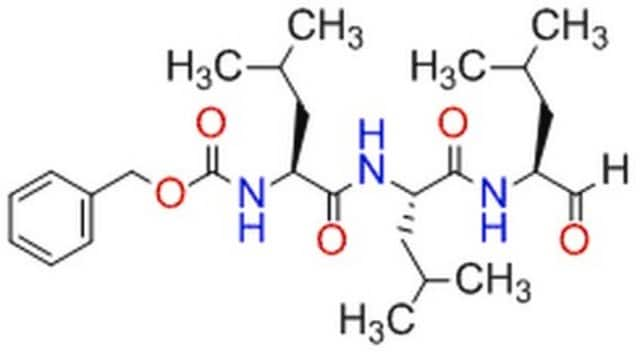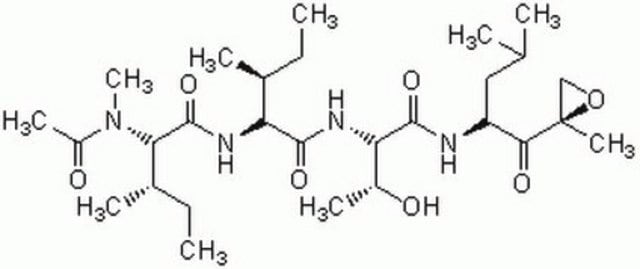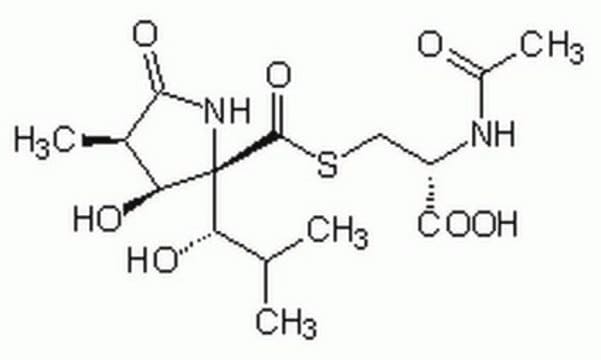474791
MG-132
InSolution, ≥98%, 10 mM, reversible proteasome inhibitor
Synonym(e):
Z-Leu-Leu-Leu-al, Carbobenzoxy-L-leucyl-L-leucyl-L-leucinal, Z-LLL-CHO, Proteasominhibitor XI, InSolution MG-132, MG-132
About This Item
Empfohlene Produkte
Qualitätsniveau
Assay
≥98% (HPLC)
Form
liquid
Hersteller/Markenname
Calbiochem®
Lagerbedingungen
OK to freeze
protect from light
Versandbedingung
wet ice
Lagertemp.
−20°C
SMILES String
[H]C(=O)[C@H](CC(C)C)NC(=O)[C@H](CC(C)C)NC(=O)[C@H](CC(C)C)NC(=O)OCc1ccccc1
InChI
1S/C26H41N3O5/c1-17(2)12-21(15-30)27-24(31)22(13-18(3)4)28-25(32)23(14-19(5)6)29-26(33)34-16-20-10-8-7-9-11-20/h7-11,15,17-19,21-23H,12-14,16H2,1-6H3,(H,27,31)(H,28,32)(H,29,33)/t21-,22-,23-/m0/s1
InChIKey
TZYWCYJVHRLUCT-VABKMULXSA-N
Suchen Sie nach ähnlichen Produkten? Aufrufen Leitfaden zum Produktvergleich
Amino Acid Sequence
Allgemeine Beschreibung
Biochem./physiol. Wirkung
Verpackung
Warnhinweis
Physikalische Form
Sonstige Hinweise
Adams, J., und Stein, R. 1996. Ann. Rep. Med. Chem.31, 279.
Lee, D.H. und Goldberg, A.L. 1996. J. Biol. Chem.271, 27280.
Wiertz, E.J.H.J., et al. 1996. Cell84, 769.
Read, M.A., et al. 1995. Immunity2, 493.
Rock, K.L. et al., 1994. Cell78, 761.
Rechtliche Hinweise
Lagerklassenschlüssel
10 - Combustible liquids
WGK
WGK 2
Flammpunkt (°F)
188.6 °F - closed cup - (Dimethylsulfoxide)
Flammpunkt (°C)
87 °C - closed cup - (Dimethylsulfoxide)
Analysenzertifikate (COA)
Suchen Sie nach Analysenzertifikate (COA), indem Sie die Lot-/Chargennummer des Produkts eingeben. Lot- und Chargennummern sind auf dem Produktetikett hinter den Wörtern ‘Lot’ oder ‘Batch’ (Lot oder Charge) zu finden.
Besitzen Sie dieses Produkt bereits?
In der Dokumentenbibliothek finden Sie die Dokumentation zu den Produkten, die Sie kürzlich erworben haben.
Kunden haben sich ebenfalls angesehen
Verwandter Inhalt
Select different protease inhibitor types based on your needs to prevent protein degradation during isolation and characterization and safeguard proteins in sample prep.
Unser Team von Wissenschaftlern verfügt über Erfahrung in allen Forschungsbereichen einschließlich Life Science, Materialwissenschaften, chemischer Synthese, Chromatographie, Analytik und vielen mehr..
Setzen Sie sich mit dem technischen Dienst in Verbindung.











